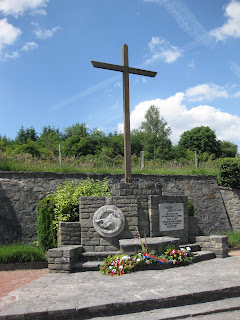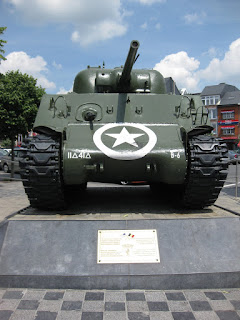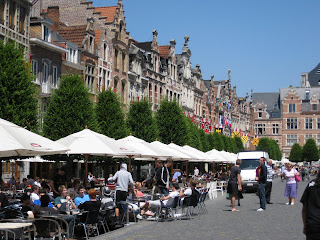
















So I realize (because it’s September) that I have fallen a bit behind on my blogging, and that in doing so I have close to none, if anyone who will read this blog. However, I feel that for sake of closure and for my own reflection time in the years to come, I must finish out the adventures. Thus I lament:
How do you possibly do everything you’ve grown to love over the course of a year, in just one week? That was the question we were forced to answer as we entered into the grand finale of our year abroad. Things that had become habits, suddenly turned to necessity. Places to eat, meals to cook, parts of the city to enjoy, and friends to enjoy them with – all changed from what was once our “everyday” into our “last time.”
We entered into the last week in Leuven with that mindset and as a result, most of us had a rather hectic final week attempting to “enjoy ourselves” to the maximum capacity. Between going out to the Oude Markt for afternoon snacks and drinks, or heading to “het Snackhuisje” – our favorite sandwich place, or running to Brussels for the last time, the Leuven crew ’09 – ’10 was very busy.
Once I returned from Torino, I was only awarded about 5 days to enjoy everything in Leuven (seeing as how my return was on a Wednesday and we left early morning Sunday). Thursday I spent midday going into Brussels for the last time. Most of the group had done that while I was in Torino, so I ventured in by myself for one last trip, and to pick up some last minute souvenirs and beers. Other than that afternoon, I spent most of my remaining time in Leuven with my friends relaxing and appreciating the city. Whether it was just walking around in the warm sunshine or running around playing soccer, or sitting in the courtyard enjoying wiffleball, the last week was amazing nonetheless.
On the Friday of our final week, Liam, Ginger, Tim, and I, sadly boarded our last train and took our last grand European adventure – a trip to Bastogne. You see earlier in the semester, as a part of our homesickness, a large majority of us watched the HBO special, “Band of Brothers,” which chronicles the story of the 101st US Airborn during WWII. This unit was made famous by its fierce fighting on D-Day, in the Netherlands, Belgium, Germany, and eventually Italy. However, “the highlight” – if one can even use such a word to describe the sacrifices and heroics of what these brave men did – of the 101st was their bravery and resolve during the famed Battle of the Bulge. Known thereafter as the “Bastards of Bastogne,” the 101st Airborne held off the German advance though they were completely surrounded and only had low supplies of ammunition and proper attire for the winter.
From watching the documentary, I was able to grasp the experience of the soldiers during those hellish nights and the reality of what they went through. However, it was not until I traveled out to Bastogne, in the south of Belgium, that I was able to both place its historical significance, and appreciate what it meant to the people of city. Even today, wherever you walk in Bastogne, there are either scars of the bombardment or monuments to American heroes. We spent most of our time there appreciating both.
We started off at General McArthur’s square which was in the center of the city and more or less served as a giant parking lot surrounded by restaurants. However, it was there that we first got a piece of the American history that awaited us. In the southwest corner of the square, from our approach into the city, were a WWII Sherman tank and a monument to General McArthur. McArthur was endeared to the Belgian people and American forces after his famous expression of “NUTS!” in response to the German demand for a complete surrender of American forces. Over the course of our travel through Bastogne, we would learn how that simple comedic expression ended up having strong iconic significance and results. After reading up on a brief history of McArthur’s role in the battle, we headed out see the main museums dedicated to the Battle of the Bulge. Strolling down Rue du Sablon (the main shopping street) we got a sense of small town southern Belgium – the smell of frietzen, the warmth of the afternoon sun and the uttering of French phrases and street signs.
We first stopped at Musee en Piconrue which was the most modern of the Bastogne museums and was centered around the historical art and artifacts. It was a modern interactive museum which explored the experience of the Belgian people as well as honoring those soldiers lost. From the museum, we ventured out on a much longer walk to the outskirts of the city (at times walking along a bit of a highway) to the two most significant Bastogne monuments – the Bastogne Historical Center and the Memorial du Mardasson.
The historical center was a bit dated but very helpful and informational in providing us with the manner in which the Battle of the Bulge transpired. It was not until my visit there that I realized the true scheme of the Fuhrer and how important the American forces holding out was. Hitler’s plan was to refocus all of his energies on taking Antwerp and thus cutting off one of the main allied arteries. Thus, the Germans more or less sent all their forces north toward Belgium. For a significant part of the battle of the Bulge, the city of Bastogne was entirely surrounded by the Nazi forces, who opted to bypass the city in order to quicken their advance. However, soon the German Generals became fixated on Bastogne and embarrassed by their in ability to take it. It didn’t take long until all the forces of the German advance were heading toward the city. Despite the full force of the Nazi Army, the 101st never gave up and managed to hold off the German advance until General Patton was able to redirect troops and eventually break through to the isolated heroes and thus stop the German advance.
To honor the bravery of those forces, the Belgians built the most significant monument in Bastogne, which we headed toward next. The Memorial du Mardasson is a giant 5 pointed star monument built on the outskirts of Bastogne and located where the heart of the American forces fought. On the interior of the Monument was the story of the Battle of the Bulge. Then on the exterior were the names of all 50 of the United States. From the top of the monument, you could look out over the landscape that was once a battlefield and over the city that was bombarded. It was in those moments, looking out over the green Belgian and Luxembourg landscape, that I couldn’t help but be reminded of the first trip we ever took. The trip through France that took us to Normandy where I first began to appreciate the US troops of WWII. In that moment, watching the sun go down over Bastogne, my mind more or less ran back over the year's worth of travel. I’m not sure where the goose bumps came from – if they were from the warm sun in the cool air or my cathartic memories - but I couldn’t help but think how coincidental it was that things came full circle, that my first and last experience traveling through Europe would both evolve around the same theme: appreciating my homeland. With that moment of reflection behind me, we began our trek “home” for the final time.
It was after we finished at the monument, that we decided it was time to start getting back for the final bus and train combo back to Leuven. From the monument to the bus station was about a 4 kilometer walk – so we had our work cut out for us. We returned back to Leuven after our 3 hour train and met up with our friends on the Oude Markt. Though it was a hard time to travel (being only 2 days before we went home and most people wanted to stay and appreciate Leuven) we didn’t regret taking the time to see the historically significant city.
The Americans, who enjoyed and endured the 10 months abroad, spent most of the last few days together just enjoying each other’s presence. We went to the Oude Markt to watch the world cup together, we went on bike rides and long walks together, and we even hosted a final lunch on the last day at a local park together. The final night we all agreed to spend the last 24 hours in Leuven awake and we went out, stayed up, came back, and packed our bags to go home – all together. We spent about as much time together as possible, realizing that once we got home, things would be different. That’s not to say that we wouldn’t still be friends once we got back home, but we just recognized that things will change when we got back.
My freshman year of high school, our JV soccer coach gave a stirring speech before our county championship game that I can still recall almost word for word and that I find to be particularly relevant in describing the Loyola Nachbarhuisian’s emotions during the last few hours together in Leuven. My coach rallied our team by sitting the group down and explaining that “teams have come and gone over the many years that St. Peter’s Prep has been around. Many men have worn these jersey’s and played for that crest. But never, never in the course of history has this team been exactly the way it is now, nor will it ever be this way again.” He said, “sure the same core group of guys will last for 4 years, but people will be in and out, faces will change and new ones will be added. But right now, in this moment, this team is unique. So isn’t that enough to do something special?”
Well I spent the past 10 months in Leuven, with a very special group of individuals – people who I otherwise would have never known, spoken with, traveled with and more importantly appreciated, if it weren’t for Leuven. This amazing group has given me the opportunity to learn about myself and grown together with them. Just as tree roots eventually grow and become entwined together, so too have we, the Nachbahrhuisians grown and become stronger because we had each other to lean on.
“The Grey Havens” is the name of my blog this week, the reason being that it is the title of the final chapter of JRR Tolkien’s The Lord of the Rings, The Return of the King. Seeing as how I named my blog after the book written by Tolkein’s main characters, I figured that it was fitting to give him credit in my final entry about my adventures. That being said, just as my blog has come full circle, so too did my time in Leuven come full circle.
It was the night of August 25th, that the 24 seemingly strangers gathered together in the courtyard of the Nachbahrhuis, nervous and excited about what was to happen. Well 10 months later on the night of June 27th, that same group, once again gathered in the courtyard, starting a bonfire to burn away memories of our time abroad that we couldn’t take home. We then headed out to the Oude Markt for one last big bang. When we returned home in the daylight, after all our bags were packed and things in order, we said goodbye to our Leuven compatriots once again in the courtyard, but this time tearful. And as the procession of wheels on cobblestone made its way down the block for the final time, we headed home – home now that’s an interesting concept.


























+445.JPG)













